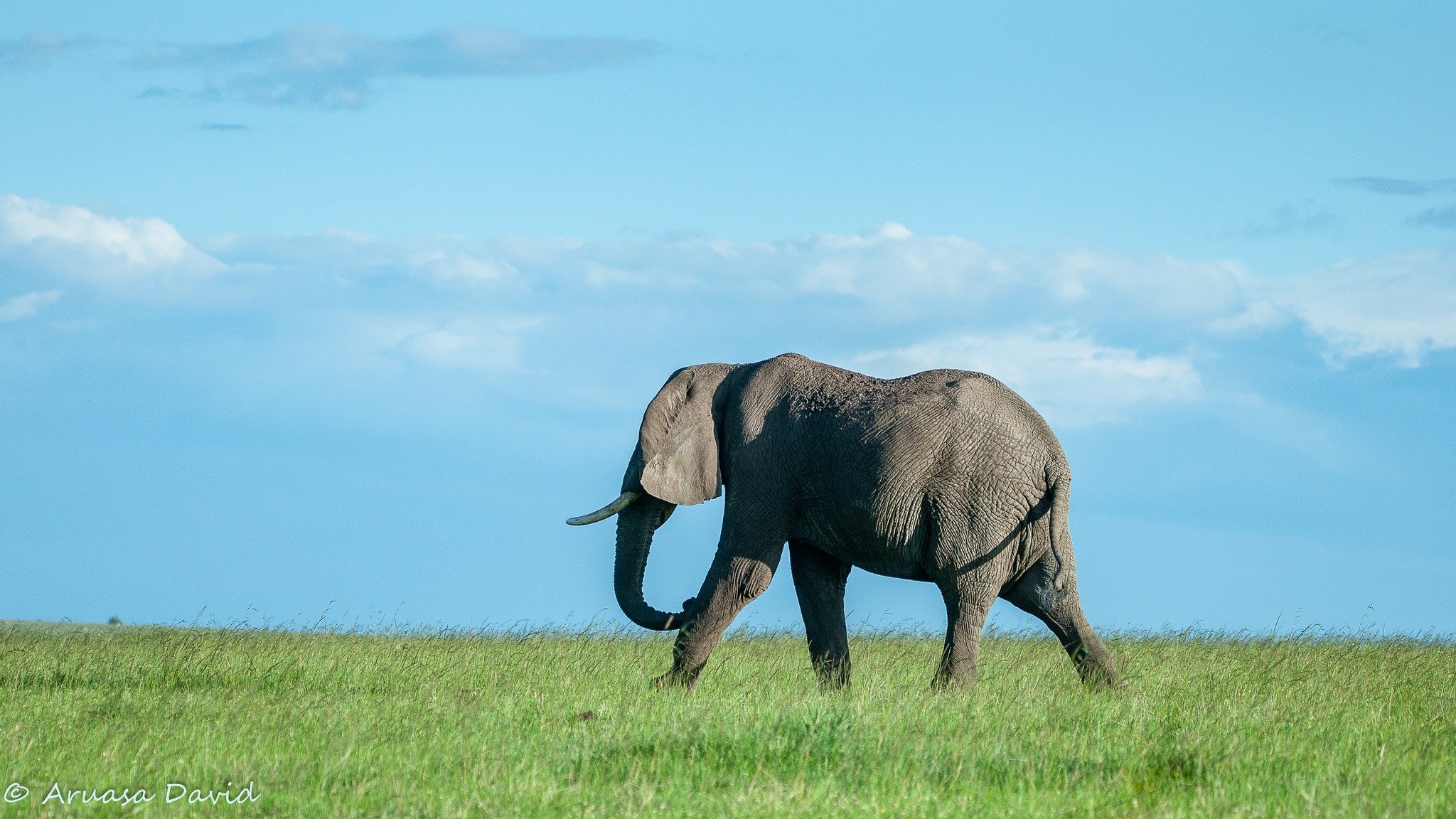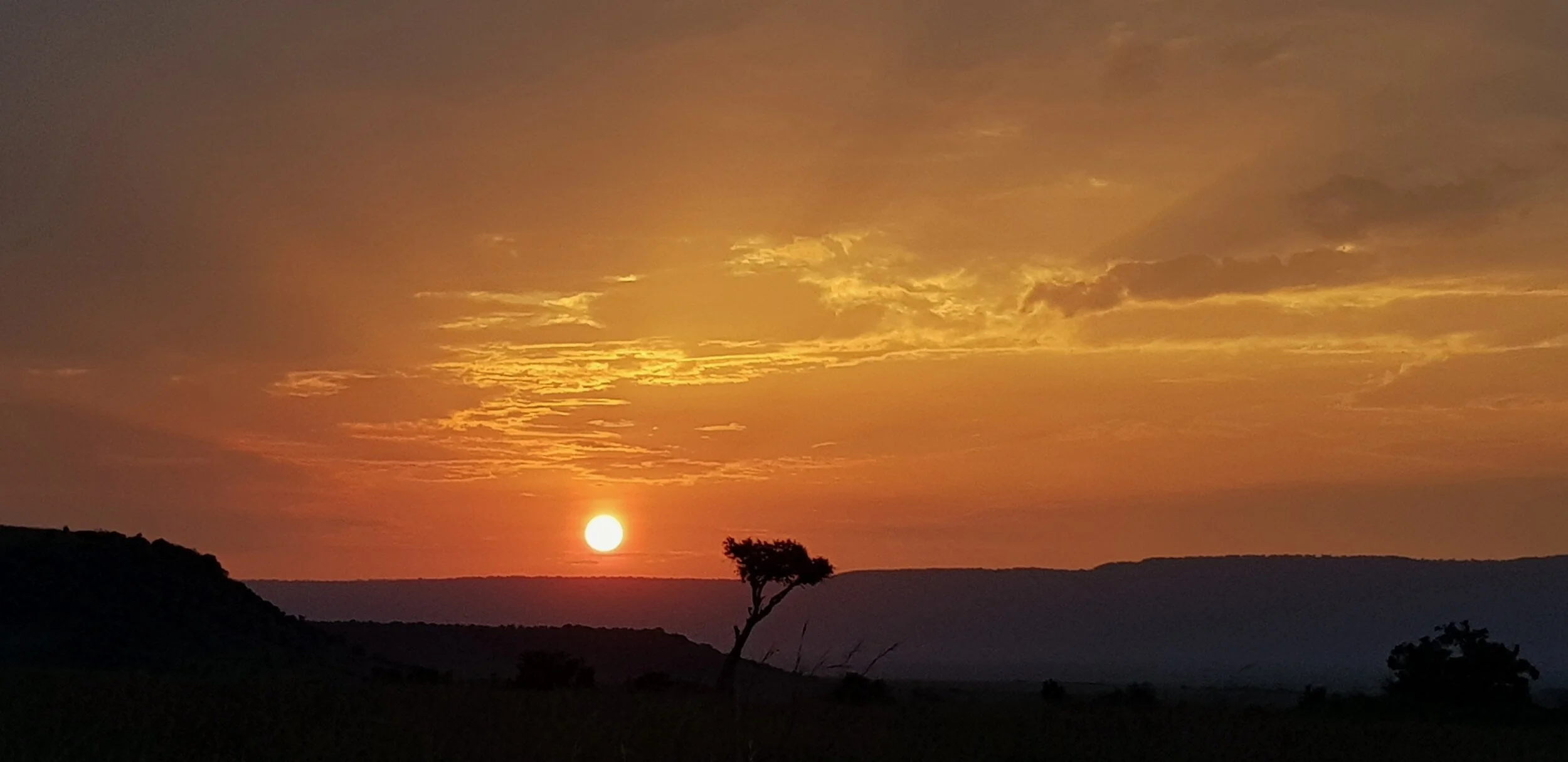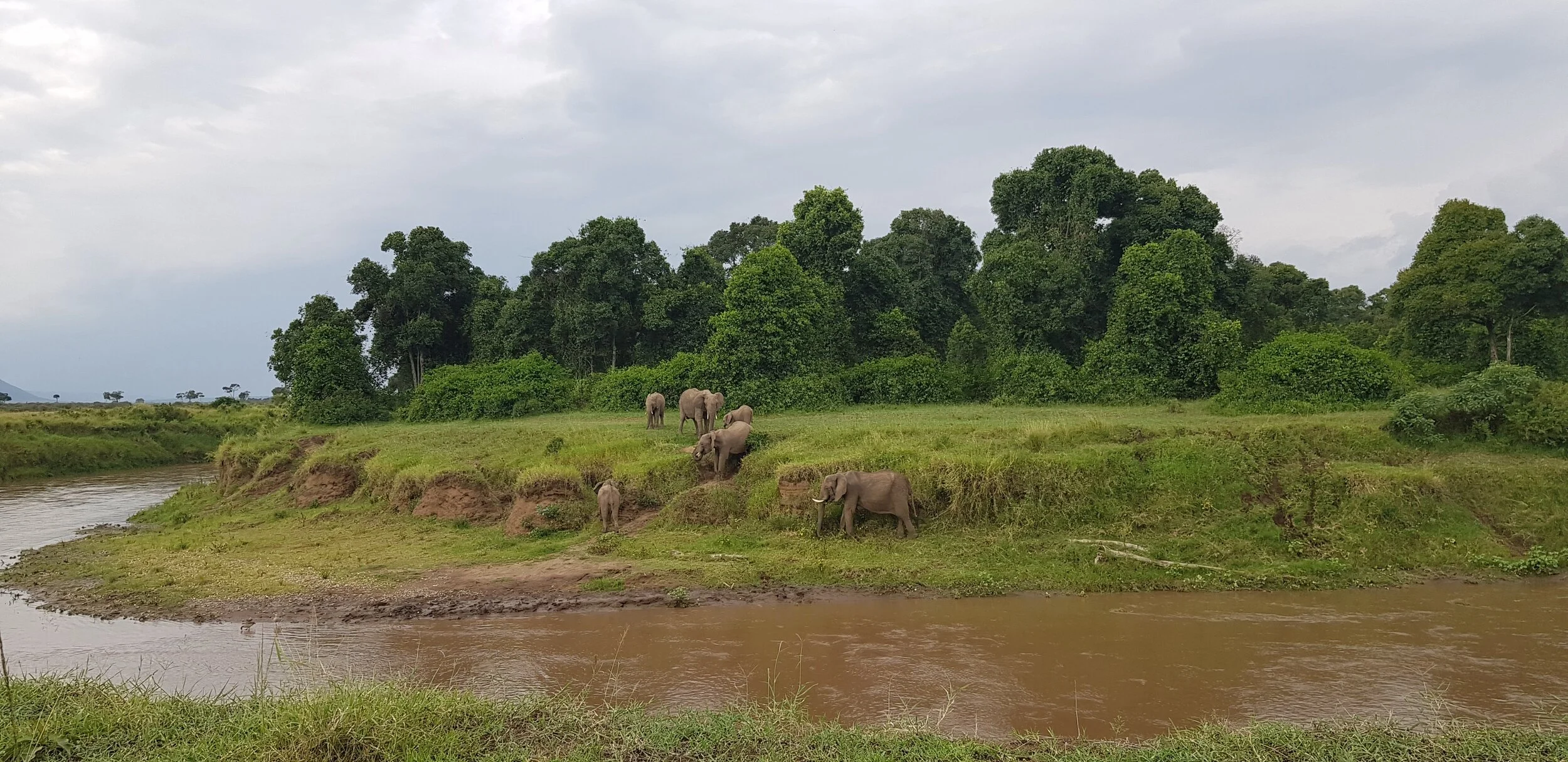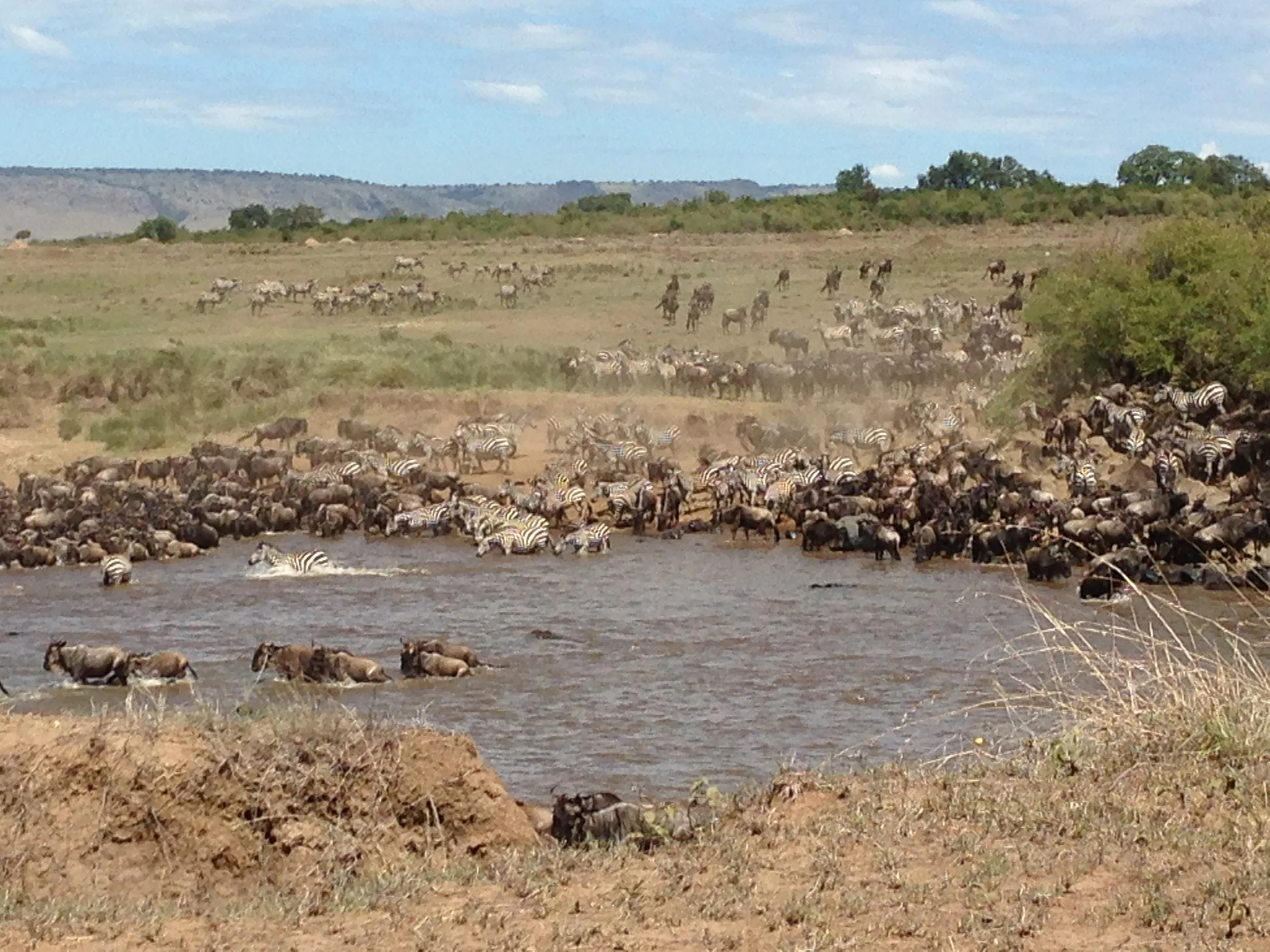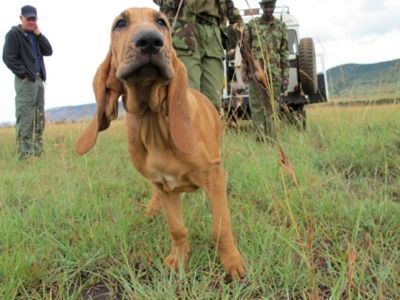Monthly Report 2025
November ended as the driest November since the Conservancy started operations over 24 years ago and there is no immediate sign of rain. If this is the case, most of Narok will suffer a drought and we can expect immense grazing pressure on the Reserve. The Triangle is fortunate in that we have had scattered showers and most it is green.
We received over 110 mm of rain this month, bringing the total to our yearly average, with two months of the short rains to go.
This month we had 130 mm of rain, bringing the total for the year to date up to 1,026.5 mm (41”). Sporadic thunderstorms throughout the month confused the wildebeest, it would rain and they would leave, it would then dry up for a few days and they would return. However, I think that heavy rain at the end of September will be sufficient to drive them away until next year
We had very heavy rain in the Triangle from the 9ᵗʰ for a few days. This was sufficient to flood the river one day and cause the migration to return to Tanzania. Within a few days there was hardly a wildebeest in the Mara. There is a chance that they may return if we get a week or two of dry weather – if not, this will rank as the worst migration in recent memory.
The first three weeks of July was overcast, with showers and thunderstorms in the evening.Although we did not receive much rain, it was sufficient to keep the grass too green to burn and the wildebeest from coming into the Triangle. However, the last week was hot and sunny, and the wildebeest started pouring in
We had 205 mm (4.2”) of rain in April, bringing the total for the year to date to 616 mm. Heavy rain on the 10ᵗʰ, causing extensive flooding. The rains in recent years have been characterized by these severe storms, causing extensive damage to roads and infrastructure. These rains are no exception.
We had slightly over 100 mm of rain throughout the month, sufficient to turn the burnt areas green, fortunately no big storms.
February was, for the most part dry and hot, with one or two storms at the very beginning of the month. This enabled us to burn one or two blocks in preparation for the rains in March/April.
We had 10 days of heavy and sustained rain amounting to nearly 200 mm. We have several days when the sun didn’t shine, overcast and drizzle most of the day and rain all night.
Monthly Report 2024
We had some heavy storms in early December, causing more damage to our roads and washing away part of the box culvert at Oloisukut – near Oloololo.
We had a total of 270 mm (nearly11”) of rain in November, much of it in the form of heavy storms in the last half of the month; causing considerable damage to the roads and making Mara Bridge impassable for days at a time.
There were a few scattered storms early in the month, sufficient to send the wildebeest back into the Serengeti - by the 15th there was hardly a wildebeest in the Mara.
We had several days of rain towards the end of the month, with heavy and sustained rain on the 29th and 30th.
There was one storm on the 3rd, with heavy rain near Ngiro-are attracting thousands of wildebeest into that corner of the Triangle. More rain on the 9th and 10th through to the 16th
The rains continued throughout the month, with some very heavy and sustained storms along the escarpment – making work on the road to Ngiro-are virtually impossible and sections of the road impassable.
Two weeks of dry weather from the 10th was very welcome. The rains returned with a vengeance on the 23rd but, at least the dry period enabled us to catch up on road repairs to Ngiro-are – very much needed as it had been too wet to work on since December.
The rains continued into February with some heavy storms through the middle of the Reserve in the first half of the month.
We had a total of 1,111.87 mm (44.5”) of rain in 2023. January will go down as the wettest in recent years, with over 275 mm (>11”) at Serena.
Monthly Report 2023
We had. A very heavy rainstorm between Mugoro and Oloololo Gate on the 6th, this flooded the Olpunyatta Plain and caused sone damage to the bridge at Sankuria.
Rains started in earnest on the 2nd, stopped for a while and then resumed towards month’s end. There was one exceptionally heavy storm near Oloololo on the 30th.
October was exceptionally dry, with only 42 mm recorded at Serena, some parts of the Triangle had more but other areas missed the rain completely.
We had widespread rain in the first 15 day, this resulted in most of the wildebeest leaving the Triangle – a number crossed into the Main Reserve, the first time in three years and several hundred drowned.
July and August have been the driest since the Conservancy started operating in the Mara, with only around 5 mm recorded at Serena for August.
The first part of April was relatively dry, enabling us to do a lot of work on the new roads in the Main Reserve and also within the Triangle.
Rain in the first few days hampered road work, we had a few days of sunshine mid-month before the rains returned with a vengeance, with heavy storms around Oloololo and Mara Bridge.
We have had reasonable rain (>110 mm), with green grass throughout the Triangle and the western portion of the Main Reserve.
We had some rain in early January, but for the most part the month was hot and dry. We are very fortunate, there is ample grass, there is more than a green tinge and grass is actually growing.
Monthly Report 2022
The first half of December was very dry and there were real concerns that the short rains would completely fail.
November was un-seasonally dry, with a little rain around the 15th. This does not bode well for much of Kenya – including the eastern portion of the Mara.
October was the driest month of the year, we had intermittent showers at the beginning but then it became very hot and dry.
We were very sad to hear that Justice (Rtd) Jonny Havelock had died during the night of the 27th after a long battle with cancer.
We had a week of intermittent showers from the 14th, sufficient to keep the grass green and bring the migration back into the Triangle.
The first two weeks of April were hot, windy and dry, this enabled us to burn two areas before the rains started on the 16th.
We has a few days of beautiful sunny weather at the beginning of the month, a welcome change from the wet overcast days that characterized half of January and most of February.
The heavy rain continued throughout February (nearly 200 mm or 8” this month alone) and the prognosis is for heavier than average rainfall for the next three months.
Monthly Report 2021
This was the driest December for the 20 years we have been in the Mara, that is until the last two days of the month, when we had decent rain.
The rains were sporadic, light and local throughout November, with some areas hardly getting any at all.
There was a heavy rainstorm on the 3rd and an even heavier storm on the 17th.
We had a few days of rain from the beginning of the month, this confused the wildebeest and for a few days we must have had half a million of them in the Triangle.
We had rain from the 3rd to the 15th, with some quite heavy storms along the escarpment and towards Oloololo Gate.
The President visited the Triangle with his family and friends on the 6th and 7th. They had a game drive followed by a picnic lunch at Kiboko Camp on the 7th.
We had days of light rain and the occasional thunderstorm before one very heavy storm on the 10th.
March was for the most part dry, with the exception of one or two heavy showers and one very destructive storm at the beginning of the month.
We had a few days of glorious, sunny weather at the beginning of the month before the rains returned on the 6th.
There was heavy and widespread rain over the first three weeks of January, resulting in more flooding and leaving large areas of the Triangle completely waterlogged.
Monthly Report 2020
This past year must rank as the most difficult in living memory. Companies destroyed, livelihoods turned upside down, families torn apart – and yet we managed to get through it, and there might be light at the end of the tunnel.
We had some very heavy storms from the 10th, triggering the migration back into the Serengeti. There was a particularly heavy storm on the 16th and then scattered storms throughout the remainder of the month.
We had scattered showers and thunderstorms throughout the month, sufficient to keep the grass green and some wildebeest herds around. However, most of them moved off by the 20th.
We had a number of heavy, sustained rainstorms throughout the month, causing some damage to the roads and confusion in the wildebeest herds.
It was very dry until the 13th when we had sufficient rain to settle the dust, we than had some heavy storms intermittently until the end of the month. Sufficient to send the wildebeest into the main Reserve and back into the Serengeti.
The rains returned with a vengeance around the 12th, flooding areas, destroying sections of the road network and ensuring that all the grasslands were waterlogged.
The exceptional rain continued throughout most of March, one storm on the 28th caused extensive damage to our infrastructure, especially the roads.
We continued to have heavy and destructive storms in the first five days of February, we then had a slight respite for two weeks, with beautiful sunny days, before the rains returned with a vengeance.
There were some heavy storms throughout January, making road repairs very difficult. This was definitely some of the heaviest and most sustained rainfall in many years.
Monthly Report 2019
December was the wettest period we have had in over a decade, probably the wettest since the Conservancy started operation.
We had heavy and sustained rain in the last half of November, probably the heaviest for several years.
There were one or two heavy storms around Oloololo at the beginning of the month and then we had a few days of widespread rain and thunderstorms from the 18th .
We had a number of rainstorms in the first week of September, sending most of the wildebeest into the Lemai Wedge and northern Serengeti.
There was a week of rain at the end of the month, sufficient to give the grass a green tinge, but not enough to add much water to the dams and watercourses.
There were a few days of rain around the end of the first week, it was sufficient to increase the flow in the Mara River slightly, before dropping to even lower levels.
We had a few days of rain from the 2nd, it was then dry for most of March, with two days of rain at the very end. We managed to partly burn one block along the escarpment just before the rain at the end of the month.
By the middle of the month the Mara River was lower than it has ever been – each year for the past several years we have said the same.
We had heavy and widespread rain for over a week around the middle of the month, this sent all the zebra North and there were large crossings for several days.
Monthly Report 2018
There were isolated showers until the 9th, when there was heavy and widespread rain.
November has been remarkably dry, certainly the driest for several years.
There were a few days of reasonable, but isolated, rain from the 9th, mainly along the escarpment.
The rain continued for the first three days and then stopped for the remainder of the month, making September one of the driest months in a long time.
The first three weeks of August were predominantly dry but wildebeest numbers remained very low for this time of year.
The rains continued throughout April and the river rose to the highest levels since December 2006.
Very heavy rain on the 3rd, causing extensive flooding – at least one camp on Mara North was severely damaged, with tents and vehicles washed away.
Most of February was very hot, dry and windy and the Mara River virtually stopped flowing by the 20th; there was a slight reprieve when we had some rain in the last week, culminating in a heavy thunderstorm on the 28th, resulting in a marginal increase in river flow.
There were two days of heavy and widespread rain on the 3rd and 4th, a spin-off from a cyclone off Madagascar.
Monthly Report 2017
Monthly Report 2016
Monthly Report 2015
The rains continued throughout April – with some heavy storms from the 11th. By the end of the month there had been considerable damage to our roads and most of the Triangle was waterlogged.
February was, for the most part, dry; with the exception of three days of rain in the middle of the month
Monthly Report 2014
Monthly Report 2013
Monthly Report 2012
Monthly Report 2011
The heavy rains continued into early October. The weather then cleared and we had three weeks of glorious, sunny weather, interspersed with one or two days of rain – that is, until the 26th, when we had some exceptionally heavy storms and sustained rain for three days.
Monthly Report 2010
Monthly Reports 2009
Monthly Reports 2008
Monthly Reports 2007
Monthly Report 2006
The dry spell in July and August ended with three weeks of scattered thunderstorms and showers, this rain led to a mass exodus of wildebeest out of the Triangle and into the Narok side of the Mara and by the 20th there was hardly a wildebeest to be seen in the Triangle
We had a few sporadic storms throughout the early part of the month, only one or two were heavy enough to stimulate grass growth.
Monthly Report 2005
There was some widespread, albeit light rain in the first week of December that concentrated the wildebeest in the western half of the Triangle.
The rains started at the beginning of the month with daily showers, they then petered out and November was, on the whole, dry with beautiful sunny days.
There were a few isolated storms in the middle of October but on the whole October was a dry month.
We had two weeks of rain from the 14th, this was in the form of heavy evening showers and isolated thunderstorms.
Daily showers in early July and, in places, local storms continued to hamper our work programme. However, the weather cleared for two weeks and we were able to grade the main Mara Bridge to Oloololo gate road and all the roads to Kichwa, Mpata, Olonana and Little Governors.
We normally expect June to be a dry month but the weather pattern that has been typical all year continued with two weeks of sunshine followed by several days of heavy, prolonged rain in the evening and at night.
We had heavy and localised storms between the 1st and 16th and then widespread storms again in the last week of the month.
We had a few days respite from rain before heavy, all night, storms resumed on the 3rd for a week, washing away sections of the roads between Oloololo and Mara Bridge; the rains then resumed on the 28th.
Exceptionally heavy and destructive storms characterised the rains in the first week of March.
Heavy rains continued into early February and then stopped until the last three days of the month, when heavy and widespread storms continued.
Heavy rains continued daily for the first half of the month, leaving large expanses sodden, with tall grass and no animals.
Monthly Report 2004
There were several very heavy storms over most of the Triangle just after New Year, again starting the 13th and continuing intermittently for the remainder of the month.
Monthly Report 2003
Monthly Report 2002
There was heavy rain almost every day in the second half of December, the storms were particularly heavy along the Oloololo Escarpment and between Mara Serena and Little Governor’s.
There was rain for most days in the first three weeks of November, filling up most of the water courses and pans.
July was for the most part dry, with one or two heavy showers and thunderstorms in the last week.
There were very heavy rains during the first three weeks of May, causing extensive flooding and making many of the tracks impassable.
Heavy rains coincided with the new moon and continued, sporadically, for the rest of the month. The rains were certainly not as heavy or extensive as anticipated for April.
The month was interspersed with heavy rainfall, followed by a series of dry days, overall not as wet as January.
The month was characterised by rain almost every day, culminating in some very widespread and heavy storms in the last week.
Monthly Report 2001
Two weeks of heavy rain in the middle of the month has greened up the whole Reserve.
The a few remnants of the wildebeest migration have left the Tanzanian border and moved up towards Serena. One crossing near the Mara bridge resulted in at least 300 wildebeest deaths.
A number of rain storms throughout September appear to have further disrupted the migration, there were large concentrations of wildebeest along the Tanzanian border, but the never moved North of Ol Are (the salt springs).
The migration has been very sporadic and weak, although large herds of wildebeest have been seen along the Tanzanian border in the last week of August.



































